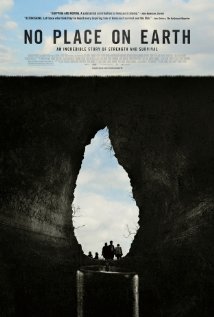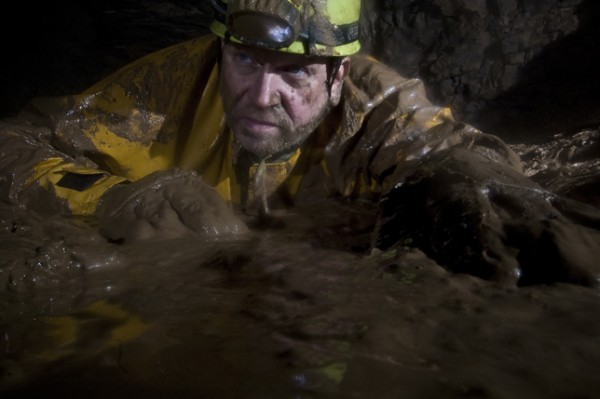
We will probably never know all the stories connected to the WWII Holocaust, but this one shatters the heart and awakens the mind to the danger and heroism that came about during the Nazi regime. It’s called No Place On Earth a documentary with dramatic interpretation of what took place in 1942 when 38 Ukrainian Jews were forced to live in a dark cavern for 511 days to escape death. Taught, terrifying and unconscionable the well directed movie plays to all faiths and ethnic groups as are reminder that something like this should never happen again.
Imagine yourself hiding in a cave because you are persecuted, now close your eyes and think that you are in this cave and it’s 70 feet deep, damp with little food and you are 5-years-old, now add the fear of being discovered brought out into the cold and shot to death by Nazis. I’m sure most adults have seen a film about the holocaust (Schindler’s List) or even one about trying to get free from tyranny (Machine Gun Preacher). True and documented stories like No Place On Earth awaken the mind to the possibility that it can happen anywhere and if given the power to a despot, probably will.
The film follows spelunker and cave expert Chris Nicola back to the depths of Verteba and Priest’s Grotto in western Ukraine where the 38 Jews spent over a year below the earth in their attempt to escape death from Hitler’s Nazis. There he takes you inside to see where the group huddled first a Verteba until they were discovered and then to some 70 feet below the surface at a cave called Priest’s Grotto. When he touches the bottom of the cave we see evidence of the people who hid among a dangerous maze tunnels. Simple things left behind like buttons, a shoe and a key are shown still in the place where these lives hid from man’s inhumanity to man.
The film then takes a turn and we meet some of the survivors as they give voice over while their plight is acted out by amazing first time actors who live their ordeal. At night the younger men go out of the caves and scavenge for food and other needs while their families hide in near total darkness except for a few candles only lit for a short period of time. Children try to occupy their time gaining knowledge from their elders, while mothers put together what little they have to eat. The film goes on from there with on camera interviews by the survivors and children of those who made it to safety from the caves.
With insertions of Nazi cruelty from captured film and very realistic scenes depicted under the fine direction by Janet Tobias, we get the whole story. Maybe not all of it because some accounts will never be heard from those who were killed or sent to the ghettos. While they were victims, there are also heroes, the young men who risked their lives to find food, pay for special needs and provide an escape route if detected. These are the special few who helped to save their families who would have died at the demands of the Nazis.
FINAL ANALYSIS: A well made documentary with excellent testimony and dramatic interpretation. (A)
The following are five of the survivors who accompanied cave expert Chris Nicola back to the places they hid and speak on film about their ordeal:
Saul Stermer (Survivor): Esther and Zaide Stermer had 3 boys and 3 girls. Saul is their middle son and the heroic carpenter in NO PLACE ON EARTH. After their remarkable survival in caves for 511 days, the Stermer family tried to pick up their lives in Ukraine but continued post-war violence against Jews forced them to leave in 1946 and make their way to the safety of a DP (Displaced Persons) Camp in Germany. Saul and his older brother Nissel (now deceased) were allowed to immigrate to Canada posing as tailors (they paid someone to take the tailor exam for them!) Once in Canada, they founded a very successful construction company in Montreal. Nissel died in 2003, but the vibrant Saul, at age 92, still goes to work where he shares the helm with Nissel’s son.
Saul has three children, seven grandchildren and two great-grandchildren. Saul’s wife Czarna, the love of his life, died several years ago after more than 60 years of marriage. She, too, was a Holocaust survivor from southwest Ukraine, who survived living in the forest and by being hidden by a Ukrainian family.
Sam Stermer (Survivor): At age 86, Sam is the “baby” of the Stermer family and Saul’s younger brother. Sam left the German DP Camp after his older brothers, initially for the US but went on to Montreal, Canada to be nearer his family. Like his brothers, he also worked in construction (now retired.) Sam, a grandfather, says he is eagerly awaiting his first great-grandchild. This year he and his wife, Bella, celebrated their 61st wedding anniversary. Bella, is also a Holocaust survivor from Ukraine, where she lost most of her family in the war and does not speak about her experiences.
Sonia Dodyk (Survivor): 79-year-old Sonia is the daughter of Fischel Dodyk and Henia Stermer; Henia is Saul and Sam’s oldest sister. The brothers Nissel, Saul and Sam are Sonia’s uncles. About six months after Liberation before they fled to the German DP camps, Sonia’s father Fischel was tragically killed in the continued violence against Jews. Sonia and her younger sister, Sima, feel the loss of their adored father to this day. At age 14, Sonia immigrated to New York by herself. Just a teen, she remembers standing on the ship’s deck and seeing the Statue of Liberty for the first time. Sonia went onto marry Harold Hochman, also a Holocaust survivor from Ukraine, who lost almost all of his family in the war. Today they live on Long Island, NY where Harold, now retired, ran a meat company. They have three children and three grandchildren.
Sima Dodyk: 74-year-old Sima is Sonia’s younger sister and only sibling. Like Sonia, she still grieves the tragic murder of her father 6 months after the war’s end. From the German DP she immigrated to New York with her mother, Henia, and heroic grandmother, Esther, shortly after Sonia made her way to the US alone. Sima ultimately moved to Montreal where she married David Blitzer, a Holocaust survivor who has family that survived the war in eastern Russia. Sima has two daughters, six grandchildren and is waiting on great-grandchildren.
Additional Film Information:
- Cast: Chris Nicola, Katalin Lábán, Péter Balázs Kiss, Dániel Hegedüs, Balázs Barna Hídvégi, Fruzsina Pelikán, András Orosz, Mira Bonelli, Norbert Gogan, Réka Gavaldi, and Zucker Emanuell
- Directed by: Janet Tobias
- Genre: Docudrama, War
- MPAA Rating: PG-13 for thematic elements including brief violent images
- Running Time: 1 hr. 25 min
- Opening Date: April 26, 2013
- Distributed by: Magnolia Pictures

 April 25th, 2013
April 25th, 2013  John Delia
John Delia 

 Posted in
Posted in  Tags:
Tags: 






